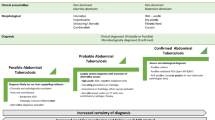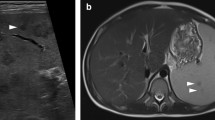Abstract
Splenic marginal zone lymphoma (SMZL) is a rare malignant B-cell neoplasm, usually with an indolent clinical course and favorable prognosis. Treatment options include chemotherapy, surgery, radiation and immunotherapy. In some recent studies an increased incidence of hepatitis C virus (HCV) infection in patients with SMZL was reported and its possible role in lymphomagenesis was emphasized. A 66-year-old woman with twelve-year history of HCV infection was admitted due to locally advanced abdominal tumor involving the spleen and the left part of the diaphragm. Transaminase serum levels were not elevated. Neither peripheral lymphadenopathy nor bone marrow pathology was found. Absolute blood lymphocyte, erythrocyte and platelet counts were normal. A splenectomy with partial diaphragm resection in one block was performed. Recovery was uneventful. Pathologic examination with immunohistochemistry revealed SMZL and confirmed a neoplastic infiltration of the resected diaphragm. Following surgery, chemotherapy (CHOP regimen) and immunotherapy (anti-CD20 antibody) were given. At the last follow-up 15 months after surgery, the patient was free of any symptoms of lymphoma. Surgical resection of even locally advanced SMZL with involvement of adjacent tissues can be performed as a diagnostic and therapeutic procedure. Splenectomy is especially indicated in symptomatic patients without other sites of the disease. HCV infection may result in increased risk of SMZL due to the induction of B-cell lymphoproliferation. Because of possible lymphoma regression following anti-viral therapy, a systematic screening for HCV in patients with SMZL seems to be valuable and helpful for treatment planning.
Similar content being viewed by others
References
Arcaini L, Paulli M, Boveri E, Vallisa D, Bernuzzi P, Orlandi E, Incardona P, Brusamolino E, Passamonti F, Burcheri S, Schena C, Pascutto C, Cavanna L, Margini U, Lazzarino M: Splenic and nodal marginal zone lymphomas are indolent disorders at high hepatitis C virus seroprevalence with distinct presenting features but similar morphologic and phenotypic profiles. Cancer 100: 107–115, 2004
Carbonari M, Caprini E, Tedesco T, Mazzetta F, Tocco V, Casato M, Russo G, Fiorilli M: Hepatitis C virus drives the unconstrained monoclonal expansion of VH1-69-expressing memory B cells in type II cryoglobulinemia: a model of infection-driven lymphomagenesis. J Immunol 174: 6532–6539, 2005
Hermine O, Lefrere F, Bronowicki JP, Mariette X, Jondeau K, Eclache-Sandreau V, Delmas B, Valensi F, Cacoub P, Brechot C, Varet B, Troussard X: Regression of splenic lymphoma with villous lymphocytes after treatment of hepatitis C virus infection. N Engl J Med 347: 89–94, 2002
Iannitto E, Ambrosetti A, Ammatuna E, Colosio M., Florena AM, Tripodo C, Minardi V, Calvaruso G, Mitra ME, Pizzolo G, Menestrina F, Franco V: Splenic marginal zone lymphoma with or without villous lymphocytes. Hematologic findings and outcomes in a series of 57 patients. Cancer 101: 2050–2057, 2004
Kelaidi C, Rollot F, Park S, Tulliez M, Christoforov B, Calmus Y, Podevin P, Bouscary D, Sogni P, Blanche P, Dreyfus F: Response to antiviral treatment in hepatitis C virus-associated marginal zone lymphomas. Leukemia 18: 1711–1716, 2004
Marasca R, Vaccari P, Luppi M, Zucchini P, Castelli I, Barozzi P, Cuoghi A, Torelli G: Immunoglobulin gene mutations and frequent use of VH1-69 and VH4-34 segments in hepatitis C virus-positive and hepatitis C virus-negative nodal marginal zone B-cell lymphoma. Am J Pathol 159: 253–261, 2001
Oscier D, Owen R, Johnson S: Splenic marginal zone lymphoma. Blood Rev 19: 39–51, 2005
Pitini V, Arrigo C, Righi M, Scaffidi M, Sturniolo G: Systematic screening for HCV infection should be performed in patients with splenic marginal zone lymphoma. Br J Haematol 124: 252–253, 2004
Svoboda J, Andreadis C, Downs LH, Miller WT Jr,Tsai DE, Schuster SJ: Regression of advanced non-splenic marginal zone lymphoma after treatment of hepatitis C virus infection. Leuk Lymphoma 46: 1365–1368, 2005
Weng WK, Levy S: Hepatitis C virus (HCV) and lymphomagenesis. Leuk Lymphoma 44: 1113–1120, 2003
Author information
Authors and Affiliations
Corresponding author
Rights and permissions
About this article
Cite this article
Szynglarewicz, B., Matkowski, R., Smorag, Z. et al. Hepatitis C virus infection and locally advanced splenic marginal zone lymphoma. Pathol. Oncol. Res. 13, 382–384 (2007). https://doi.org/10.1007/BF02940322
Received:
Accepted:
Issue Date:
DOI: https://doi.org/10.1007/BF02940322




